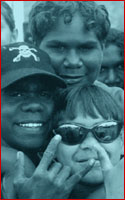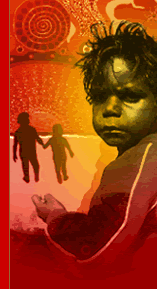| |
Background on SNAICC
The Secretariat of National
Aboriginal and Islander Child Care (SNAICC) is the national non
government peak body in Australia representing the interests of
Aboriginal and Torres Strait Islander children and families.
SNAICC was formally established
in 1981 after the creation of such a body was proposed by Aboriginal
and Torres Strait Islander people at the 'First Aboriginal Child
Survival Seminar' held in Melbourne in 1979. The organisation elected
its first national executive in 1982 and has received Federal Government
funding support from 1983.
SNAICC operates from a
membership base of Aboriginal and Torres Strait Islander community-based
child care agencies, Multi-functional Aboriginal Children's Services,
family support services, foster care agencies, link up and family
reunification services, family group homes, community groups and
voluntary associations, long day care child care services, pre schools,
early childhood education services and services for young people
at risk.
In addition to these members
SNAICC has a network and subscriber list of over 800 community groups,
mostly Aboriginal and Torres Strait Islander, but also significant
numbers of non Indigenous community based services and individuals
with an interest in Aboriginal and Torres Strait Islander families
and children.
National Executive
SNAICC is governed by
a National Executive of Aboriginal and Torres Strait Islander people
drawn from our members and operates from an office located in Melbourne
with 13 staff. You can find out more about our National Executive
here.
Milestones and Achievements
Some key milestones in
SNAICC's commitment to serving the interests of Aboriginal and Torres
Strait Islander children and families have included:
- Bringing to national prominence the story of the 'Stolen Generations'
when in 1991 SNAICC was the first national Indigenous organisation
to call for a national inquiry into the 'Stolen Generations';
- Production of Through Black Eyes - Family Violence Resource
Handbook in 1991 and 1992;
- Development of National Aboriginal and Islander Children's Day,
NAICD, (August 4th each year), as a major annual event celebrated
by communities throughout Australia;
- Representing the rights and needs of Aboriginal and Torres Strait
Islander children to the United Nations Working Group on Indigenous
Populations in 1998 and 2000;
- Research and production of the 'Proposed Plan of Action for
Child Abuse and Neglect in Aboriginal Communities' in 1996;
- Convening the second National Aboriginal and Torres Strait Islander
Child Survival conference in June 1997;
- Continuing membership of the Australian Council for Children
and Parenting following our participation in the National Council
for the Prevention of Child Abuse;
- Membership of the Federal Ministerial Council for Aboriginal
and Torres Strait Islander Affairs Family Violence Taskforce;
- Compilation of a national report on the operation of the 37
Commonwealth funded Multifunctional Aboriginal Children's Services,
MACS, for the Department of Family and Community Services;
- Convening 'Our Future Generations: National Indigenous Child
Welfare and Development Seminar' in 2003;
- Establishing the SNAICC Resource
Service to develop and share resources to support services
working with Aboriginal and Torres Strait Islander children and
families, with $4 million funding from the Australian Government
Department of Families, Community Services and Indigenous Affairs.
- Publication in 2001 of Through Young Black Eyes, a
national resource booklet and community elders guide responding
to issues of family violence and child abuse in Aboriginal and
Torres Strait Islander communities. And updated edition of Through
Young Black Eyes was published in 2005.
SNAICC'S Funding
Information on SNAICC's
funding is available here.
|
 |






